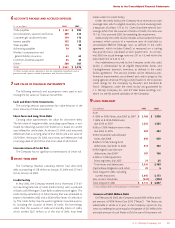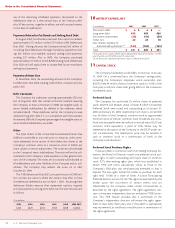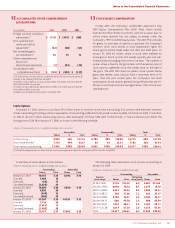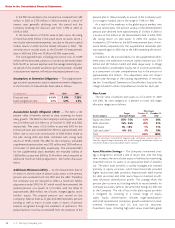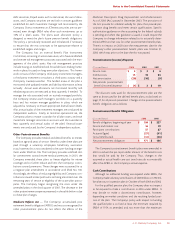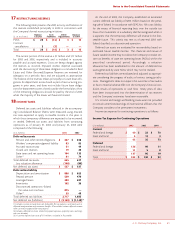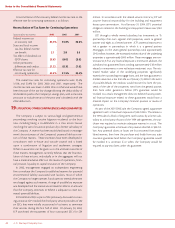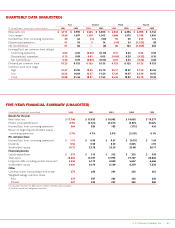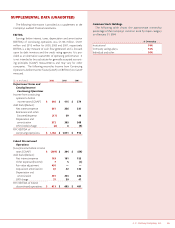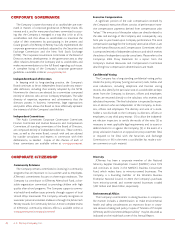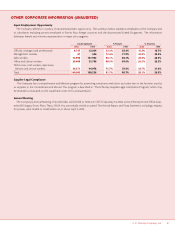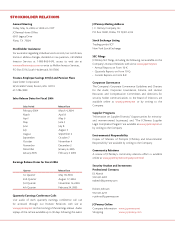JCPenney 2003 Annual Report Download - page 44
Download and view the complete annual report
Please find page 44 of the 2003 JCPenney annual report below. You can navigate through the pages in the report by either clicking on the pages listed below, or by using the keyword search tool below to find specific information within the annual report.
J. C. Penney Company, Inc.42
Notes to the Consolidated Financial Statements
A reconciliation of the statutory federal income tax rate to the
effective rate for continuing operations is as follows:
Reconciliation of Tax Rates for Continuing Operations
(percent of pre-tax income) 2003 2002 2001
Federal income tax
at statutory rate 35.0% 35.0% 35.0%
State and local income
tax, less federal income
tax benefit 2.1 2.8 2.6
Tax effect of dividends on
ESOP shares (2.6) (6.0) (2.6)
Other permanent
differences and credits (1.3) (0.3) (1.6)
Effective tax rate for
continuing operations 33.2% 31.5% 33.4%
The overall tax rates for continuing operations were 33.2%,
31.5% and 33.4% for 2003, 2002 and 2001, respectively. The
income tax rate was lower in 2002 than it otherwise would have
been because of the tax law change allowing the deductibility of
all dividends paid to the Company’s savings plan, with a one-time
provision to include certain of the prior year’s dividends with the
2002 deduction.
19 LITIGATION, OTHER CONTINGENCIES AND GUARANTEES
The Company is subject to various legal and governmental
proceedings involving routine litigation incidental to the busi-
ness, including being a co-defendant in a class action lawsuit
involving the sale of insurance products by a former subsidiary of
the Company. A reserve has been established based on manage-
ment’s best estimates of the Company’s potential liability in cer-
tain of these matters. These estimates have been developed in
consultation with in-house and outside counsel and is based
upon a combination of litigation and settlement strategies.
While no assurance can be given as to the ultimate outcome of
these matters, management currently believes that the final reso-
lution of these actions, individually or in the aggregate, will not
have a material adverse effect on the results of operations, finan-
cial position, liquidity or capital resources of the Company.
In 2002, management engaged an independent engineering
firm to evaluate the Company’s established reserves for potential
environmental liability associated with facilities, most of which
the Company no longer operates. Funds spent to remedy these sites
are charged against such reserves. A range of possible loss exposure
was developed and the reserve was increased in 2002 to an amount
that the Company continues to believe is adequate to cover esti-
mated potential liabilities.
In December 2003, as part of the previously discussed cost sav-
ings initiative, JCP notified the third-party service providers of the
six SSCs that were initially outsourced of its intent to terminate
their services during the first half of 2004. On January 30, 2004,
JCP purchased the equipment of four outsourced SSCs for $34
million. In accordance with the related service contracts, JCP will
assume financial responsibility for the building and equipment
leases upon termination. As of January 31, 2004, JCP’s potential
obligation related to the building and equipment leases was $120
million.
JCP, through a wholly owned subsidiary, has investments in 15
partnerships that own regional mall properties, seven as general
partner and eight as a limited partner. JCP’s potential exposure to
risk is greater in partnerships in which it is a general partner.
Mortgages on the seven general partnerships total approximately
$345 million; however, the estimated market value of the underlying
properties is approximately $600 million. These mortgages are non-
recourse to JCP, so any financial exposure is minimal. In addition, the
subsidiary has guaranteed loans totaling approximately $18 million
related to investments in one real estate investment trust. The esti-
mated market value of the underlying properties significantly
exceeds the outstanding mortgage loans, and the loan guarantee to
market value ratio is less than 6% as of January 31, 2004. In the event
of possible default, the creditors would recover first from the pro-
ceeds of the sale of the properties, next from the general partner,
then from other guarantors before JCP’s guarantee would be
invoked. As a result, management does not believe that any poten-
tial financial exposure related to these guarantees would have a
material impact on the Company’s financial position or results of
operations.
As part of the 2001 DMS sale, the Company signed a guarantee
agreement with a maximum exposure of $20 million. This relates to
the 1994 sale of a block of long-term care business by a former sub-
sidiary to a third party. As part of the 1994 sale agreement, the pur-
chaser was required to maintain adequate reserves in a trust. The
Company’s guarantee is the lesser of any reserve shortfall or $20 mil-
lion. Any potential claims or losses are first recovered from estab-
lished reserves, then from the purchaser and finally from any state
insurance guarantee fund before the Company’s guarantee would
be invoked. It is uncertain if, or when, the Company would be
required to pay any claims under this guarantee.



